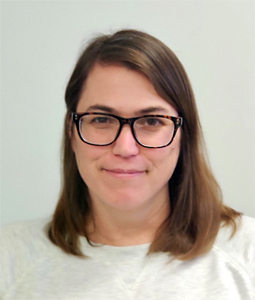Department of Biological Sciences
General Directory
Katie Kathrein
| Title: | Assistant Professor Research Concentration - Stem Cells & Developmental Biology |
| Department: | Biological Sciences McCausland College of Arts and Sciences |
| Email: | kathrein@mailbox.sc.edu |
| Phone: | 803-576-6211 |
| Office: | CLS, Room 304 |

Research
Stem cells are extraordinary cells with two important characteristics. They have the ability to self-renew or make more stem cells as well as the ability to differentiate and become other kinds of cells. Our lab uses the hematopoietic system to study this amazing cell type. In the blood, the hematopoietic stem cells (HSCs) produce all of the different blood cell lineages required by the immune system (all red and white blood cells) while also maintaining a population of stem cells. This process is regulated in part by gene expression, which can direct the cells to switch between stem cell maintenance and differentiation. These genes are regulated by numerous different proteins that change gene expression.
While transcription factor proteins are often regarded as the master regulators of HSC development, these proteins do not function alone and are often components of multi-protein complexes that have the ability to alter the 3D structure of DNA. This 3D structure is highly regulated and can be altered to suit the particular needs of the cell. To maintain organization, DNA is wrapped around histone proteins and in s structure called chromatin. Changes in chromatin structure are often associated with post-translational modification of the histone proteins that are made by chromatin modifying enzymes. Modification and remodeling of histones by numerous different protein families results in a highly regulated system of gene expression. While critical to the function of the stem cell, chromatin modifying proteins remain poorly defined in their roles as regulators of stem cells and hematopoiesis.
The primary focus of the Kathrein lab is to understand how chromatin modifying factors establish a code for HSC gene regulation to direct both stem cell maintenance and differentiation. We are seeking to identify novel chromatin remodeling complexes that regulate the hematopoietic stem cells using the Zebrafish as a model system. The Zebrafish is an ideal model for exploring the establishment of HSCs for many reasons. The process of hematopoiesis is well conserved between humans and the zebrafish and the formation of the very first HSCs can be visualized at 36 hours post fertilization (hpf). The genetic malleability of the embryos make manipulation of hematopoiesis possible at all different stages. Through these studies, we will achieve a better understanding of HSCs to improve stem cell function for hematopoietic stem cell transplants. As well, we hope to expose chromatin remodeling enzymes that function abnormally in cancer as targets for new chemotherapy treatments.
Publications
Huang H.-T.*, Kathrein K.L.*, Barton A., Gitlin Z., Huang Y.-H., Ward T.P., Hofmann
O., Dibiase A., Song A., Tyekucheva S., Hide W., Zhou Y., and Zon L.I. (2013). “A
network of epigenetic regulators guides developmental hematopoiesis in vivo.” Nat
Cell Biol. 15(12): 1516-25 2013.
*Authors contributed equally to this work.
McKinney-Freeman, S., Cahan, P., Li, H., Lacadie, S. A., Huang, H. -T., Curran, M., Loewer, S., Naveiras, O., Kathrein, K. L., Konantz, M., Langdon, E. M., Lengerke, C., Zon, L. I., Collins, J. J., Daley, G. Q. (2012). " The transcriptional landscape of hematopoietic stem cell ontogeny.” Cell Stem Cell. 11(5):701-14.
Yu, M., Mazor, T., Huang, H., Huang, H. -T., Kathrein, K. L., Woo, A. J., Chouinard, C. R., Labadorf, A., Akie, T. E., Moran, T. B., Xie, H., Zacharek, S., Taniuchi, I., Roeder, R. G., Kim, C. F., Zon, L. I., Fraenkel, E., Cantor, A. B. (2012). "Direct recruitment of polycomb repressive complex 1 to chromatin by core binding transcription factors." Mol Cell. 45(3): 330-43.
Mochida, G. H., Ganesh, V. S., de Michelena, M. I., Dias, H., Atabay, K. D., Kathrein, K. L., Huang, H.-T., Hill, R. S., Felie, J. M., Rakiec, D., Gleason, D., Hill, A. D., Malik, A. N., Barry, B. J., Partlow, J. N., Tan, W. H., Glader, L. J., Barkovich, A. J., Dobyns, W. B., Zon, L. I., Walsh, C. (2012). "CHMP1A encodes an essential regulator of BMI1-INK4A in cerebellar development." Nat Genet. 44(11): 1260-4.
Kathrein, K. L., Chari, S., and Winandy, S. (2008). "Ikaros directly represses the notch target gene Hes1 in a leukemia T cell line: implications for CD4 regulation." J Biol Chem. 283(16): 10476-84.
Kathrein, K. L., Lorenz, R., Innes, A. M., Griffiths, E., Winandy, S. (2005). “Ikaros induces quiescence and T cell differentiation in a leukemia cell line”. Mol Cell Biol. 25(5): 1645-1654.